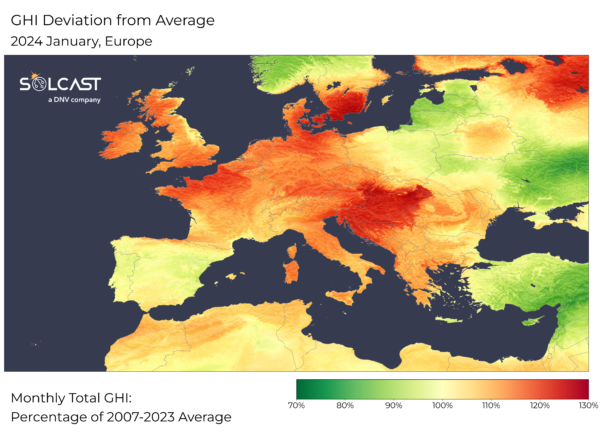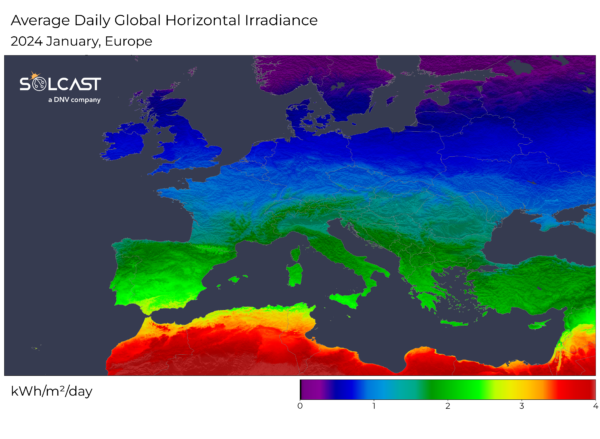In a new weekly update for pv magazine, Solcast, a DNV company, reports that almost all of Europe experienced 10-25% more irradiance than the long term January average. Spain, in particular, experienced significant rainfall and slightly below average irradiance, while parts of Northern Europe enjoyed clear and sunny days for much of the month.
February 16, 2024 Solcast
Above-average irradiance and high temperatures were seen across Europe this January, disrupting winter expectations. Almost all of Europe experienced 10-25% more irradiance than the long term January average, though Spain, Portugal and the Baltic states saw average or below average, according to analysis using the Solcast API. The impacts of both El Niño and a weak phase of the North Atlantic Oscillation (NAO) are seen in these conditions, though a southerly jet stream is also impacting the movement of moisture and cloud across the continent.
Spain, in particular, experienced significant rainfall and slightly below average irradiance, while parts of Northern Europe enjoyed clear and sunny days for much of the month. Despite seeing only average irradiance, Southern Spain still saw more daily irradiance than elsewhere in the continent, due to their southerly latitude and longer days.

The southern regions of Europe experienced warm and wet weather, in contrast to cool conditions further north. A combination of a weaker Azores high and unusually warm waters in the Atlantic brought warmer-than-average conditions across the Mediterranean. Spain’s average temperature soared to 8.4 C, beating the average by 2.4 C. Moreover, heat, rain and cloud were driven across the continent, decreasing irradiance to average or below average for all of the Iberian Peninsula.

On the other hand, Northern and Eastern Europe experienced cool and dry weather. Regions such as North France, Benelux, Germany, Northern Italy and the Balkans received irradiance 20% or more above average. This was primarily driven by northerly winds, which brought cool and dry air and clear skies to these areas. Paris and London each saw more January irradiance than they have seen in the last 15 years with the strong Mistral winds in Italy and offshore winds in the United Kingdom. Cool air from Germany and France kept Hungary’s skies, and central Europe in general, clearer.
Amidst the generally cool and dry conditions, there were notable exceptions found in some continental areas. Archfary in Scotland recorded its hottest January on record, which was also the hottest winter in Scotland and the warmest January data in the United Kingdom. Meanwhile, Sweden recorded its coldest temperature since 1999, marking a continuation of this condition for four consecutive months.
Solcast produces these figures by tracking clouds and aerosols at 1-2km resolution globally, using satellite data and proprietary AI/ML algorithms. This data is used to drive irradiance models, enabling Solcast to calculate irradiance at high resolution, with typical bias of less than 2%, and also cloud-tracking forecasts. This data is used by more than 300 companies managing over 150GW of solar assets globally.
The views and opinions expressed in this article are the author’s own, and do not necessarily reflect those held by pv magazine.
This content is protected by copyright and may not be reused. If you want to cooperate with us and would like to reuse some of our content, please contact: [email protected].
>>> Read full article>>>
Copyright for syndicated content belongs to the linked Source : PV-Magazine – https://www.pv-magazine.com/2024/02/16/unusual-winter-weather-led-to-record-breaking-january-in-europe/































